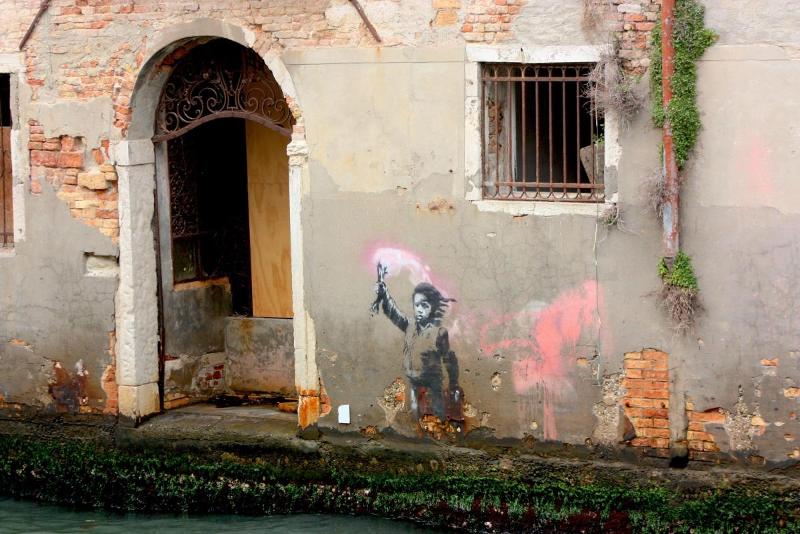Banksy's iconic mural, Migrant Child, has become a symbol of artistic expression and social commentary. However, the decision to restore this masterpiece has sparked a heated debate. Some argue that the gradual deterioration adds a poetic element to the artwork, while others believe it should be protected and exhibited in safe conditions. Join me as we delve into the controversy surrounding the restoration of Banksy's Migrant Child.
The Deterioration Debate: To Restore or Not to Restore
Explore the conflicting opinions surrounding the restoration of Banksy's Migrant Child mural
The restoration of Banksy's Migrant Child mural has ignited a passionate debate within the art community. On one side, there are those who argue that the gradual deterioration of the artwork adds to its poetic and transient nature. They believe that street art should be left untouched by restoration efforts. On the other side, there are those who advocate for the preservation and protection of this iconic piece. They argue that restoring the mural will ensure its longevity and allow future generations to appreciate its message.
What are your thoughts on this debate? Should the mural be restored or left to naturally deteriorate? Share your opinion in the comments below.
The Power of Transience in Street Art
Discover the poetic beauty behind the gradual deterioration of street art
Street art is known for its transient nature, with artworks often appearing overnight and disappearing just as quickly. This impermanence adds a layer of intrigue and mystique to the art form. The gradual deterioration of street art, like Banksy's Migrant Child mural, can be seen as a reflection of the transient nature of life itself.
As time weathers the surface of the artwork, it creates a unique patina that adds to its artistic value. The cracks, peeling paint, and fading colors tell a story of the passage of time and the ever-changing urban landscape. This natural decay becomes an integral part of the artwork, enhancing its poetic beauty.
Preservation versus Exhibition: Finding a Balance
Explore the challenges of preserving street art while making it accessible to the public
Preserving street art poses a unique challenge. Unlike traditional artworks that are housed in museums or galleries, street art is often created illegally on public walls. This raises questions about ownership, conservation, and accessibility.
Some argue that detaching the artwork from the wall and exhibiting it in a controlled environment would ensure its long-term preservation. This approach would protect the artwork from further deterioration due to weather conditions or vandalism. However, others believe that street art should be experienced in its original context, embedded within the urban landscape.
How can we strike a balance between preserving street art and making it accessible to the public? Share your ideas in the comments below.
The Role of Restoration in Protecting Contemporary Art
Examine the responsibility of preserving and protecting contemporary art
As an undersecretary in Italy's culture ministry, Vittorio Sgarbi has taken on the responsibility of restoring Banksy's Migrant Child mural. He argues that it is his duty to protect contemporary art, regardless of its legality or the artist's permission.
Restoration not only ensures the longevity of the artwork but also allows future generations to appreciate and interpret its message. By preserving contemporary art, we preserve a piece of our cultural heritage and provide a platform for artistic expression.
What are your thoughts on the role of restoration in protecting contemporary art? Share your insights in the comments below.
Conclusion
The restoration of Banksy's Migrant Child mural has sparked a passionate debate between those who advocate for preservation and those who believe in the beauty of its gradual deterioration. While some argue that street art should be left untouched to maintain its transient nature, others argue for its protection and exhibition in controlled environments. Ultimately, the decision to restore or not to restore raises important questions about the role of preservation in contemporary art.
As the restoration of Banksy's Migrant Child moves forward, it is clear that the future of this iconic mural remains uncertain. The ongoing debate surrounding its fate serves as a reminder of the power of street art to provoke discussion and challenge our perceptions of art and its preservation.
FQA
Should street art be preserved or left to naturally deteriorate?
The answer to this question is subjective and depends on one's perspective. Some argue that the gradual deterioration adds to the poetic nature of street art, while others believe in preserving and protecting these artworks for future generations to appreciate.
What is the significance of the gradual deterioration of street art?
The gradual deterioration of street art can be seen as a reflection of the transient nature of life itself. It adds a unique patina and tells a story of the passage of time and the ever-changing urban landscape.
How can we strike a balance between preserving street art and making it accessible to the public?
Finding a balance between preservation and accessibility is a complex challenge. Some suggest detaching the artwork from the wall and exhibiting it in controlled environments, while others believe in experiencing street art in its original context within the urban landscape.
What is the role of restoration in protecting contemporary art?
Restoration plays a crucial role in preserving and protecting contemporary art. It ensures the longevity of the artwork and allows future generations to appreciate and interpret its message. By preserving contemporary art, we preserve a piece of our cultural heritage.

